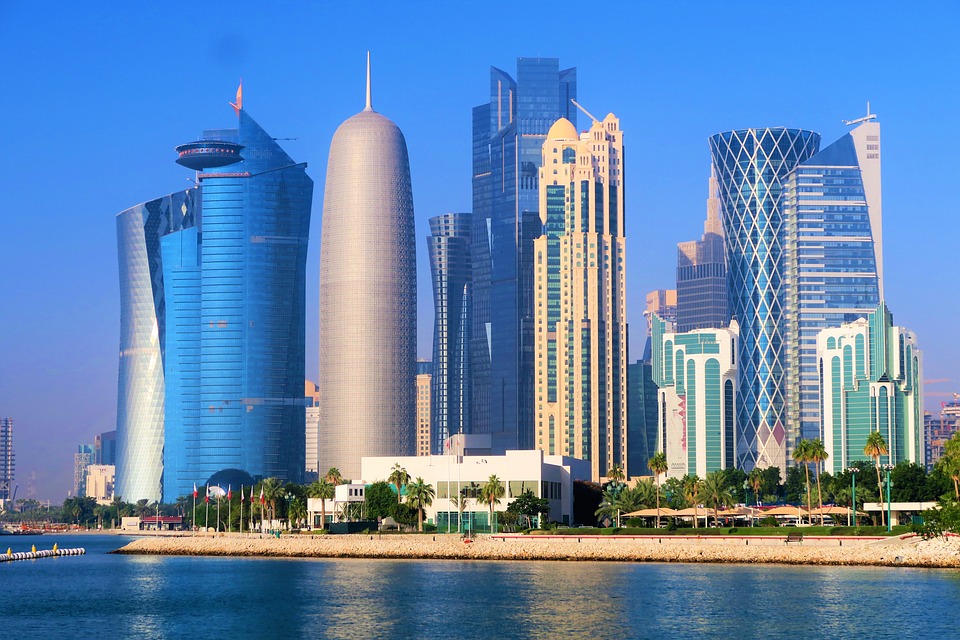World Cup host Qatar is drier than anywhere in Australia
With the Socceroos progressing to the knockout phase of the FIFA World Cup after defeating Denmark 1-0, we thought it might be a good time to talk about the weather in Qatar.
For the record, the Socceroos' next match against Lionel Messi's Argentina kicks off at 6 am Sunday morning (AEDT). That's 10 pm Qatar time, on a night when temps are tipped to dip to 22°C after a high of 29°C. So conditions should be perfect for both spectators and players.
But we thought we'd share some stats and info about Qatar's weather in general, and compare its climate to the drier, hotter parts of Australia. What we discovered was pretty interesting.
Qatar really is drier than anywhere in Australia
True story. You might think that a country as vast as Australia – approximately a third of which is desert – must be drier somewhere than a tiny country like Qatar. But no.

Image: The Doha city skyline. Source: Pixabay.
Qatar is a tiny country just one-sixth the size of Tasmania located on a peninsula in the Persian Gulf (aka the Arabian Gulf), a notably dry part of the world.
Because it's so small with few hills or valleys of note and a highest point of just 103 m, it's pretty safe to take stats from Qatar's capital Doha as representative of the whole country's climate.
And Doha has only about 80 mm of rain each year, most of it in the midyear northern summer period. That makes it drier than anywhere in Australia, as you can see clearly on the map below.

Image: Qatar's climate would fit into the lighter of the two beige shades. Source: BoM.
As you can see, the driest part of Australia is the beige blob centred around the northern part of South Australia, with smaller chunks of Western Australia’s Nullarbor, the SE corner of the Northern Territory, far SW Queensland, and even a tiny fragment of NW New South Wales.
This is the zone that's located too far south for reliable tropical moisture from the north, and a little too far north for reliable rainfall emanating from the Southern Ocean.
But even this arid part of Australia receives in the range of 100 to 200 mm annually, which as mentioned is more than Qatar’s average annual rainfall.
We should also note that the beige-shaded area experiences slightly colder temperatures than Qatar in the winter months, especially at night in the winter months.
Is any part of Australia similar to Qatar in terms of climate?
While nowhere in Australia is quite as dry as Qatar, or quite as relentlessly hot throughout summer in terms of the average temperatures, there is a small zone with pretty similar year-round conditions.
That would be the part of NW Western Australia covered by the Pilbara and Gascoyne forecasts districts.
- For example, the weather site at Learmonth RAAF base, near the town of Exmouth, has average maximum temperatures of 38°C in the hottest month and just 245 mm of rain annually. We mention this site because it sits on a peninsula, just like Doha in Qatar.
- An even more similar location to Doha in terms of temperatures would be Marble Bar. While the iconic WA outpost has much more rain with 379.9 mm annually, its average max temp in the hottest month (December) is 42.1°C. Doha averages around 42°C in its three hottest months.
The areas in Western Australia just mentioned sit within the red zone of the Köppen climate classification map (the Köppen classification is a tool used to compare climate in different locations around the world).
As you can see, Qatar and that small section of NW Western Australia are both coastal locations that sits within the red zone (which identifies hot desert climates).

Image: A climate-type map of the world. Source: Creative Commons.
Meanwhile, we are expecting the action to be extremely hot on the pitch, as Lionel Messi – the player many believe to be the greatest of all time – meets a force called Aussie spirit. Go the Socceroos.